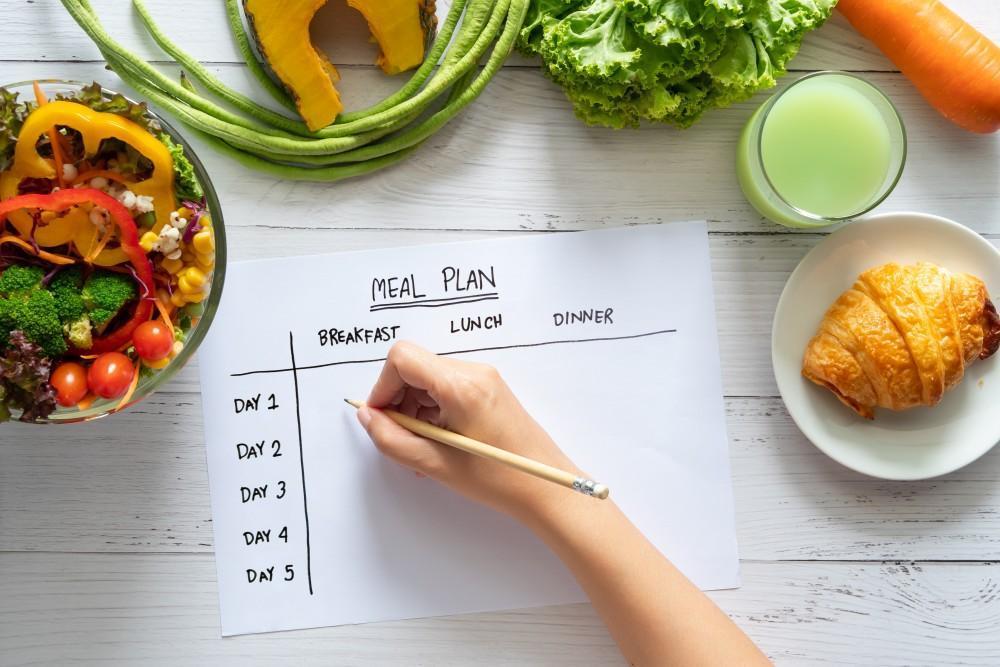Table of Contents
- Understanding the Basics of a Budget-Friendly Eating Plan
- Essential Strategies for Meal Planning on a Shoestring
- Smart Shopping Tips to Maximize Your Grocery Budget
- Creative Cooking Techniques to Reduce Food Waste
- Tools and Resources for Effective Budget Meal Management
- Q&A
- In Summary


Understanding the Basics of a Budget-Friendly Eating Plan
Creating a budget-friendly eating plan requires a combination of careful planning and smart shopping strategies. Start by assessing your weekly grocery needs and categorizing them into essential items and treats. Focus on whole foods, such as grains, legumes, fruits, and vegetables, which tend to be more cost-effective and nutritious. Make a list of staples like:
- Rice and pasta
- Canned beans and lentils
- Seasonal fruits and vegetables
- Frozen produce
- Eggs and dairy products
Pre-planning your meals can significantly cut down on impulse purchases and waste. Consider creating a weekly meal schedule that incorporates the items you’ve bought. Aim to prepare batch meals, which not only save time but also money by reducing the need for multiple smaller purchases throughout the week. Below is a sample budgeting table to help you visualize your weekly expenses:
| Food Item | Cost per Unit | Quantity | Total Cost |
|---|---|---|---|
| Rice | $1.50/lb | 2 lbs | $3.00 |
| Frozen Vegetables | $2.00/bag | 3 bags | $6.00 |
| Canned Beans | $0.80/can | 4 cans | $3.20 |
| Eggs | $2.50/dozen | 1 dozen | $2.50 |
| Oats | $3.00/box | 1 box | $3.00 |
explore local markets and discount stores to find better prices and deals on your shopping list. Buying in bulk can often yield discounts, and choosing store brands instead of name brands can further minimize spending. Look out for weekly sales and plan your meals around those promotions to maximize your budget. Implementing these strategies will not only help you maintain a nutritious diet but also ensure your finances are in check.


Essential Strategies for Meal Planning on a Shoestring
Meal planning on a budget doesn’t have to be a daunting task. By embracing a few essential strategies, you can create nutritious meals without breaking the bank. Start by designing a weekly meal calendar that highlights your budget and incorporates seasonal produce. This not only helps in planning but also ensures you take advantage of lower prices for fresh ingredients. A well-structured calendar can prevent impulse buying and waste, allowing you to focus on the essentials.
Next, consider batch cooking and freezing meals for later use. This practice helps you make the most of your time and resources, reducing the frequency of grocery shopping trips. Choose a day to dedicate to preparation, where you can cook large quantities of grains, legumes, and proteins. Storing portions in freezer-safe containers ensures you have ready-to-eat options available, eliminating the temptation to order takeout when you’re short on time. You can categorize your meals into types such as:
- Proteins: Grilled chicken, baked beans, or lentil stew
- Grains: Quinoa, brown rice, or whole wheat pasta
- Vegetables: Stir-fried broccoli, roasted peppers, or mixed greens
Lastly, utilize a shopping list that aligns with your weekly meal plan. This simple yet effective tool aids in keeping your spending in check and minimizes the risk of impulse purchases. Organize your list based on sections of the grocery store to streamline your shopping experience. To illustrate, here’s a basic shopping list template you might follow:
| Category | Items |
|---|---|
| Proteins | Eggs, canned tuna, chickpeas |
| Grains | Whole grain bread, oatmeal, couscous |
| Fruits & Vegetables | Bananas, frozen spinach, carrots |
| Dairy/Alternatives | Milk, yogurt, plant-based milk |
| Snacks | Peanut butter, popcorn, apples |


Smart Shopping Tips to Maximize Your Grocery Budget
Staying within your grocery budget doesn’t have to feel like a never-ending struggle. One effective method is to plan your meals for the week before heading to the store. Meal planning allows you to create a shopping list tailored to your needs, which helps in reducing impulse purchases. Consider using a worksheet to jot down your menu and corresponding ingredients. This way, your shopping is focused and efficient, optimizing both time and money spent.
Incorporate seasonal and local produce into your shopping strategy. Seasonal foods often come at lower prices and are fresher and more nutritious than out-of-season items. Furthermore, visiting farmers’ markets or local farms can yield both discounts and the opportunity to purchase in bulk, allowing you to preserve or freeze items for future meals. Don’t forget: shopping for ingredients that can be used across multiple meals maximizes your investment and minimizes waste.
Another smart shopper tip is to utilize store loyalty programs and digital coupons. Many supermarkets now offer apps that provide exclusive deals and discounts. By downloading these apps and signing up for newsletters, you can gain access to special promotions that traditional flyers do not advertise. Additionally, keeping an eye on store circulars can alert you to weekly sales, letting you stock up on essentials at reduced prices. Here’s a simple table to help you track your spending and savings:
| Item | Planned Spend | Actual Spend | Discounts/Savings |
|---|---|---|---|
| Vegetables | $20 | $15 | $5 |
| Meat | $25 | $20 | $5 |
| Grains | $15 | $15 | $0 |
| Dairy | $10 | $8 | $2 |


Creative Cooking Techniques to Reduce Food Waste
One of the most effective ways to embrace culinary creativity while minimizing food waste is by utilizing leftovers in imaginative ways. For instance, instead of tossing yesterday’s roasted vegetables, chop them up and incorporate them into a zesty frittata or savory quiche. Blending leftover meats and grains can also yield a hearty and flavorful stir-fry or grain bowl, proving that yesterday’s dinner can easily transform into today’s lunch with just a pinch of ingenuity. Tapping into these resources not only cuts down on waste but also enhances your meal options.
Another technique is to embrace the concept of picking and preserving. Instead of letting your fruits and vegetables go past their prime, consider pickling or fermenting them. This method not only extends their lifespan but also introduces exciting flavors to your meals. Making a simple pickled vegetable medley can serve as a appealing condiment, while fermented products like sauerkraut or kimchi can add depth to various dishes. Harnessing these techniques can turn soon-to-be-forgotten items into flavorful favorites.
Lastly, explore the art of creative meal planning that incorporates all parts of the ingredients. Take vegetable scraps, such as celery tops, carrot peels, and onion skins, and use them to create a homemade vegetable broth. Similarly, that last bit of bread can be transformed into croutons or breadcrumbs for an array of dishes. Here’s a quick visual guide to maximize ingredient usage:
| Ingredient | Creative Use |
|---|---|
| Vegetable Scraps | Homemade Vegetable Broth |
| Stale Bread | Croutons or Breadcrumbs |
| Fruit Peels | Candied Treats or Zests |
Embracing these innovative cooking techniques not only enhances your culinary repertoire but also represents a responsible approach to food sustainability. By rethinking how you use ingredients, you’re paving the way for both budget-friendly meals and a healthier planet.


Tools and Resources for Effective Budget Meal Management
To successfully manage your meals on a budget, consider utilizing a variety of digital tools and resources that can streamline your planning and shopping processes. Apps such as You Need a Budget (YNAB) and Mint not only help track your finances but also allow you to allocate specific amounts for groceries and meal expenses. Additionally, websites like MyFitnessPal can assist in meal planning while providing nutritional information. These resources make it easier to stay within your financial limits while making conscious food choices.
Another effective strategy is to leverage printable worksheets dedicated to budget meal planning. Checklists and meal planners available online can simplify the task of organizing your weekly meals. You can create a shopping list based on your meal planner to avoid impulse buying. Consider organizing your expenses by category; for instance, differentiate between fresh produce, grains, proteins, and snacks. A well-structured list can prevent overspending and ensure you purchase only what you need.
| Category | Average Cost | Budget-Friendly Options |
|---|---|---|
| Fruits & Vegetables | $20-$30 | Seasonal Produce |
| Grains | $10-$15 | Brown Rice, Oats |
| Proteins | $25-$35 | Legumes, Eggs |
| Dairy/Substitutes | $15-$20 | Yogurt, Plant Milks |
Lastly, exploring community resources can significantly enhance your budget meal management. Local food banks and community gardens often offer fresh produce at little to no cost. Engaging with online communities, such as forums or social media groups focused on frugal living, can provide inspiration, meal ideas, and support. By collaborating and sharing resources with others who are also budget-conscious, you can enrich your meal planning experience while stretching your food dollars further.
Q&A
Q&A: Eating on a Budget Worksheet
Q1: What is an “Eating on a Budget Worksheet”? A: An Eating on a Budget Worksheet is a practical tool designed to help individuals and families plan their meals while keeping track of expenses. It typically includes sections for listing groceries, outlining meal plans, and calculating costs, making it easier to stay within a specified budget.Q2: Why should I use an Eating on a Budget Worksheet? A: Utilizing an Eating on a Budget Worksheet can significantly reduce food-related stress. It helps you make intentional food choices, minimizes impulse spending, and encourages meal planning, which can result in healthier eating habits and better financial management.
Q3: How do I create my own Eating on a Budget Worksheet? A: You can create your own worksheet by starting with simple columns: one for the grocery items, one for estimated costs, and another for actual costs. Add a section for meal planning, detailing which meals will utilize which groceries. Templates are also available online for quick access!
Q4: What are some tips for meal planning on a budget? A: To meal plan effectively, try these strategies: focus on seasonal produce, buy in bulk, use leftovers creatively, stick to a shopping list, and incorporate pantry staples into your meals. Planning around weekly sales can also help stretch your dollar further.
Q5: Can I still eat healthy while using a budget worksheet? A: Absolutely! Eating healthily on a budget is entirely feasible. Incorporate whole foods like grains, beans, and seasonal vegetables into your meal plans. Planning meals that focus on these ingredients not only saves money but also promotes better nutrition.
Q6: How often should I update my Eating on a Budget Worksheet? A: It’s best to update your worksheet weekly to reflect any changes in your budget, meal choices, or grocery prices. Regular updates can help you track your spending and make adjustments as needed, ensuring you stay on target financially.
Q7: Where can I find resources to assist with meal planning and budgeting? A: There are numerous online resources available, from budgeting apps to printable worksheets. Websites focusing on personal finance, parenting, or cooking often provide valuable tips, recipes, and tools to enhance your meal planning capabilities.
Q8: What if I need to adjust my budget mid-month? A: If you find that your initial budget needs adjustments, don’t hesitate to reevaluate your expenses. Analyze where you can cut back—perhaps by reducing non-essential items or rethinking your meal plan. Flexibility is key!
Q9: Is it possible to eat out on a budget? A: Yes, eating out on a budget is possible! Look for restaurants with specials, consider dining out for lunch instead of dinner when prices might be lower, and take advantage of discount deals or coupons. Just remember to include these costs in your worksheet.
Q10: How does an Eating on a Budget Worksheet promote mindfulness in eating? A: By planning your meals and tracking your expenses, you become more aware of your eating habits and food choices. This increased mindfulness can lead to healthier alternatives, reduced food waste, and a greater appreciation for the meals you prepare.




0 Comments